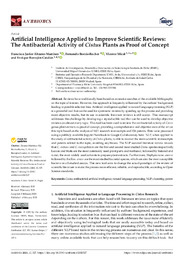Por favor, use este identificador para citar o enlazar este ítem:
https://hdl.handle.net/11000/30427Registro completo de metadatos
| Campo DC | Valor | Lengua/Idioma |
|---|---|---|
| dc.contributor.author | Álvarez-Martínez, Francisco Javier | - |
| dc.contributor.author | Borras Rocher, Fernando | - |
| dc.contributor.author | Micol, Vicente | - |
| dc.contributor.author | Barrajón-Catalán, Enrique | - |
| dc.contributor.other | Departamentos de la UMH::Ingeniería | es_ES |
| dc.date.accessioned | 2023-12-20T07:39:16Z | - |
| dc.date.available | 2023-12-20T07:39:16Z | - |
| dc.date.created | 2023-02 | - |
| dc.identifier.citation | Antibiotics Volume 12 Issue 2 | es_ES |
| dc.identifier.issn | 2079-6382 | - |
| dc.identifier.uri | https://hdl.handle.net/11000/30427 | - |
| dc.description.abstract | Reviews have traditionally been based on extensive searches of the available bibliography on the topic of interest. However, this approach is frequently influenced by the authors’ background, leading to possible selection bias. Artificial intelligence applied to natural language processing (NLP) is a powerful tool that can be used for systematic reviews by speeding up the process and providing more objective results, but its use in scientific literature reviews is still scarce. This manuscript addresses this challenge by developing a reproducible tool that can be used to develop objective reviews on almost every topic. This tool has been used to review the antibacterial activity of Cistus genus plant extracts as proof of concept, providing a comprehensive and objective state of the art on this topic based on the analysis of 1601 research manuscripts and 136 patents. Data were processed using a publicly available Jupyter Notebook in Google Collaboratory here. NLP, when applied to the study of antibacterial activity of Cistus plants, is able to recover the main scientific manuscripts and patents related to the topic, avoiding any biases. The NLP-assisted literature review reveals that C. creticus and C. monspeliensis are the first and second most studied Cistus species respectively. Leaves and fruits are the most commonly used plant parts and methanol, followed by butanol and water, the most widely used solvents to prepare plant extracts. Furthermore, Staphylococcus. aureus followed by Bacillus. cereus are the most studied bacterial species, which are also the most susceptible bacteria in all studied assays. This new tool aims to change the actual paradigm of the review of scientific literature to make the process more efficient, reliable, and reproducible, according to Open Science standards. | es_ES |
| dc.format | application/pdf | es_ES |
| dc.format.extent | 32 | es_ES |
| dc.language.iso | eng | es_ES |
| dc.publisher | MDPI | es_ES |
| dc.rights | info:eu-repo/semantics/openAccess | es_ES |
| dc.rights | Attribution-NonCommercial-NoDerivatives 4.0 Internacional | * |
| dc.rights.uri | http://creativecommons.org/licenses/by-nc-nd/4.0/ | * |
| dc.subject | Cistus | es_ES |
| dc.subject | antibacterial | es_ES |
| dc.subject | artificial intelligence | es_ES |
| dc.subject | natural language processing | es_ES |
| dc.subject | NLP | es_ES |
| dc.subject | clustering | es_ES |
| dc.subject | patent | es_ES |
| dc.title | Artificial Intelligence Applied to Improve Scientific Reviews: The Antibacterial Activity of Cistus Plants as Proof of Concept | es_ES |
| dc.type | info:eu-repo/semantics/article | es_ES |
| dc.relation.publisherversion | https://doi.org/10.3390/antibiotics12020327 | es_ES |

Ver/Abrir:
antibiotics-12-00327(reducido=.pdf
1,12 MB
Adobe PDF
Compartir:
 La licencia se describe como: Atribución-NonComercial-NoDerivada 4.0 Internacional.
La licencia se describe como: Atribución-NonComercial-NoDerivada 4.0 Internacional.
.png)